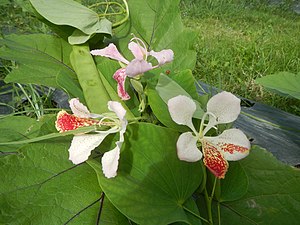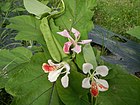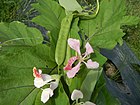Note: This is a project under development. The articles on this wiki are just being initiated and broadly incomplete. You can Help creating new pages.
Difference between revisions of "Bauhinia purpurea"
| Line 52: | Line 52: | ||
==How to plant/cultivate== | ==How to plant/cultivate== | ||
A plant of subtropical to tropical regions where it can usually be found at elevations from 500 - 2,000 metres, exceptionally to 3,000 metres.<ref name="How to plant/cultivate"/> | A plant of subtropical to tropical regions where it can usually be found at elevations from 500 - 2,000 metres, exceptionally to 3,000 metres.<ref name="How to plant/cultivate"/> | ||
| + | |||
| + | ==Season to grow== | ||
| + | <ref name="Season to grow"/> | ||
| + | |||
| + | ==Required Ecosystem/Climate== | ||
| + | <ref name="Required Ecosystem/Climate"/> | ||
| + | |||
| + | ==Kind of soil needed== | ||
==Commonly seen growing in areas== | ==Commonly seen growing in areas== | ||
Revision as of 18:59, 3 November 2020
Bauhinia purpurea is an erect, evergreen shrub. It grows up to 7 - 10 metres tall. The tree has a wide range of local uses. It should also make an excellent pioneer species and is commonly cultivated as an ornamental.
Contents
- 1 Uses
- 2 Parts Used
- 3 Chemical Composition
- 4 Common names
- 5 Properties
- 6 Habit
- 7 Identification
- 8 List of Ayurvedic medicine in which the herb is used
- 9 Where to get the saplings
- 10 Mode of Propagation
- 11 How to plant/cultivate
- 12 Season to grow
- 13 Required Ecosystem/Climate
- 14 Kind of soil needed
- 15 Commonly seen growing in areas
- 16 Photo Gallery
- 17 References
- 18 External Links
Uses
[[:Category:Ayurvedic Herbs known to be helpful to treat |]], [[:Category:Ayurvedic Herbs known to be helpful to treat |]], [[:Category:Ayurvedic Herbs known to be helpful to treat |]], [[:Category:Ayurvedic Herbs known to be helpful to treat |]], [[:Category:Ayurvedic Herbs known to be helpful to treat |]], [[:Category:Ayurvedic Herbs known to be helpful to treat |]], [[:Category:Ayurvedic Herbs known to be helpful to treat |]], [[:Category:Ayurvedic Herbs known to be helpful to treat |]], [[:Category:Ayurvedic Herbs known to be helpful to treat |]], [[:Category:Ayurvedic Herbs known to be helpful to treat |]], [[:Category:Ayurvedic Herbs known to be helpful to treat |]].
Parts Used
Seeds, Flower buds, Flowers, Root.
Chemical Composition
Eleven new secondary metabolites (1−11), together with two known flavanones (12 and 13) and five known bibenzyls.[1]
Common names
| Language | Common name |
|---|---|
| Kannada | ಕಂಚುವಾಳ Kanchuvaala, ಕಂಚಿವಾಳ Kanchivaala |
| Hindi | Kaniar |
| Malayalam | |
| Tamil | Nilattiruvatti |
| Telugu | |
| Marathi | Rakta kanchan |
| Gujarathi | |
| Punjabi | |
| Kashmiri | |
| Sanskrit | Devakanchan |
| English | Purple Orchid Tree, Butterfly tree |
Properties
Reference: Dravya - Substance, Rasa - Taste, Guna - Qualities, Veerya - Potency, Vipaka - Post-digesion effect, Karma - Pharmacological activity, Prabhava - Therepeutics.
Dravya
Rasa
Guna
Veerya
Vipaka
Karma
Prabhava
Habit
Identification
Leaf
| Kind | Shape | Feature |
|---|---|---|
Flower
| Type | Size | Color and composition | Stamen | More information |
|---|---|---|---|---|
| {{{5}}} |
Fruit
| Type | Size | Mass | Appearance | Seeds | More information |
|---|---|---|---|---|---|
Other features
List of Ayurvedic medicine in which the herb is used
Where to get the saplings
Mode of Propagation
How to plant/cultivate
A plant of subtropical to tropical regions where it can usually be found at elevations from 500 - 2,000 metres, exceptionally to 3,000 metres.[4]
Season to grow
Required Ecosystem/Climate
Kind of soil needed
Commonly seen growing in areas
Mixed deciduous forests, On hill slopes.
Photo Gallery
References
- ↑ Chemical constituents
- ↑ Common names
- ↑ [Morphology]
- ↑ Cultivation
- ↑ Cite error: Invalid
<ref>tag; no text was provided for refs namedSeason to grow - ↑ Cite error: Invalid
<ref>tag; no text was provided for refs namedRequired Ecosystem/Climate
External Links
- Pages with reference errors
- Ayurvedic Herbs known to be helpful to treat
- Herbs with Seeds used in medicine
- Herbs with Flower buds used in medicine
- Herbs with Flowers used in medicine
- Herbs with Root used in medicine
- Herbs with common name in Kannada
- Herbs with common name in Hindi
- Herbs with common name in Tamil
- Herbs with common name in Marathi
- Herbs with common name in Sanskrit
- Herbs with common name in English
- Habit - Evergreen tree
- Index of Plants which can be propagated by Seeds
- Index of Plants which can be propagated by Cuttings
- Herbs that are commonly seen in the region of Mixed deciduous forests
- Herbs that are commonly seen in the region of On hill slopes
- Herbs
- Pages without herbs images





